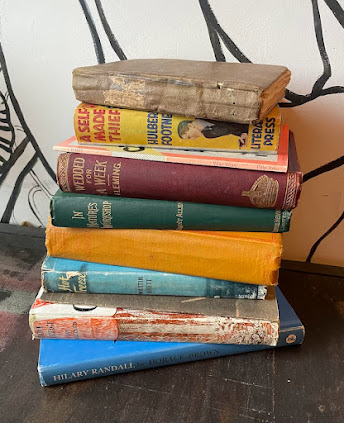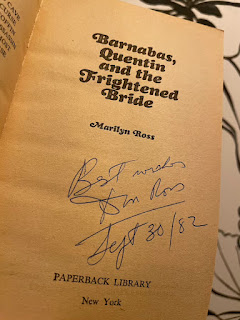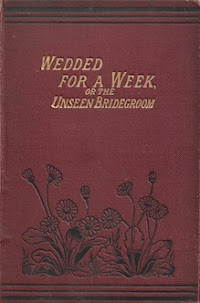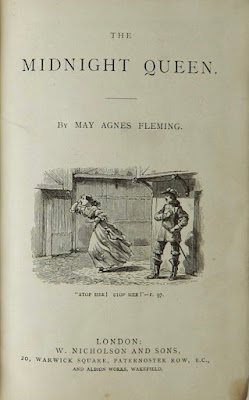A Wronged Wife
[The Twin Sisters; Or, The Wronged Wife's Hate]
May Agnes Fleming
New York: Carleton, [c. 1883]
420 pages
A Wronged Wife was first published in 1864, the year before its author, then May Agnes Early, met and married machinist John W. Fleming. I think this worth noting because that union was a complete disaster with Mr Fleming exposing himself as a drunkard given to physical violence. Mrs Fleming proved herself the stronger. A victim of Bright's disease at thirty-nine, she managed to leave behind a will – which stuck – in which her husband was denied her money and their four children. Anyone with so much as a passing knowledge of nineteenth-century Canada will be astonished by this accomplishment.
 |
Types of Canadian Women or Women Who Are
or Have Been Connected With Canada
H.J. Morgan, editor
Toronto: William Briggs, 1903
|
There are plenty of wronged wives in May Agnes Fleming's fiction, but I've yet to encounter another so vindictive as the one in this novel. The story begins with a train arriving in the village of Riverside, a sunny summer retreat to Manhattanites of means. This being a "drear and dark December day," no one is expected to disembark, so it comes as a surprise when a man known to the locals as "Captain Forrest," a regular visiter in warmer months, does just that. Under cover of darkness, he makes his way to a ramshackle house, steals two sleeping toddlers, then makes off who knows where.
The next scene takes place some days later on Christmas Eve (1844, by my calculation) in the large, lavishly appointed Fifth Avenue brownstone of wealthy widower Alexander Hazlewood. His is a full house comprised of three adult sons, two nieces, a recently widowed sister, and an unspecified number of servants. Old school chum Dr Jeremiah Lance has stopped by for a visit. The eldest niece and three Hazelton sons are preparing to leave for a party when they're interrupted by "a shrill scream from the hall below." The chambermaid has come upon a pair of toddlers – twin girls – who have somehow been deposited just inside the front doors, along with this note:

"It's a vile slander!" declares crimson-faced Mr Hazlewood, "It’s the work of some infamous being who has taken this means of securing a home
for the offspring she will not rear."
Dr Lance, a sour bachelor whose proposal of marriage was decades earlier turned down by the aforementioned widowed sister, is not so quick to dismiss: "Black eyes, black hair, fresh complexion, and
good features—all characteristics of the Hazelwoods?" And, really, if the two girls were mere street urchins, why are they so elaborately and expensively dressed?"
Why, indeed!
Enter the three Hazelton sons: handsome heartthrob Conway, delicately dishy August, and ugly Eugene:
It's an uncomfortable situation, but not so much as to delay the brothers' departure for the party. And who can blame them! Beautiful Helen Thornton, who ranks amongst New York's greatest heiresses, is hostess! Mr Hazelwood is well aware and well pleased that the desirable Helen has eyes only for Conway. His other sons, who aren't quite so observant, bare their hearts to Helen, and are rejected. By party's end, Conway and Helen are engaged to be wed.
As preparations take over the Hazelwood household, one might be forgiven in forgetting the toddler twins. They've not been shuffled off-stage, nor shuttled to the alms-house, as Mr Hazelwood had threatened, rather they remain in the Fifth Avenue brownstone. Once wed, beautiful Helen wants to adopt the girls – which is not to suggest that she believes her betrothed to be their father.
Meanwhile, Eugene has gone missing. Having been spurned by Helen, he's set off to solve the riddle of the twins' paternity.
The evening before the wedding, a figure disguised in in blackface confronts Conway on Broadway telling him that he must show himself in Thornton conservatory at half-past ten the next morning... that is, if he knows what's good for him.
On the day of the wedding, beautiful Helen receives this intriguing note:
Against her maid of honour's advice – always listen to your maid of honour – beautiful Helen does just as the note instructs. The novel's second scream comes when the bride is discovered dead in the conservatory. A distraught Conway, who dismissed the instructions he'd received the previous evening, learns that the missing Eugene had been in the conservatory mere minutes before Helen's body was found. He has his brother arrested and charged with Helen's murder. Eugene maintains his innocence, but not even his broken-hearted father believes him.
He's found guilty, is sentenced to death, and hangs himself with a bed sheet.
This whirlwind of events comes to a climax in the form of a letter received on the evening of the suicide:
 |
| cliquez pour agrandir |
Wow!
I've given away much of the plot, but not enough to spoil. Rose Hazelwood's letter appears roughly one-third through the novel, and there's so much more to come: a riding accident, a second suicide, a third kidnapping, and several additional deaths within the Hazelton family. This reader was surprised that nothing aligned with the path of vengeance indicated in the letter. Was this the author's plan? Was there a plan, or was she just writing furiously for money?
May Agnes Fleming published more than two dozen novels in her thirty-nine years. Nowhere in the
one,
two,
three,
four other Fleming titles I've read is there one so self-referential:
- Dr Lance describes the appearance of the twins with accompanying note as something “absurd and
mysterious enough for a three-volume novel."
- Arthur likens their appearance to "a thing from a play or a story."
- The widowed sister tells her niece that "it would be like a story in a novel if the twins turned out to be Conway's children." (To which the niece replies: "such things only happen in novels.")
- Helen's murder and the surrounding drama is not only dramatized for the stage, but serves as inspiration for "sensation-novelists."
- Male characters liken themselves, or are likened, to heroes of novels.
As in other Fleming novels coincidence piles upon coincidence, the difference here being height and instability. The most amusing part of the A Wronged Wife comes when the narrator (omniscient) remarks on the improbability of three Americans, none of whom had seen each other in well over a decade, encountering each other in the Quebec village of St Croix.
It's an old storyteller's trick. In recognizing and remarking on one unbelievable coincidence, the others seem less incredible. May Agnes Fleming was a pro;
"Canada’s first outstanding success as a professional novelist," she was like no other of her day.
She knew how to make money... a lot of money.
And she knew how to keep it from her husband.
Favourite sentence:
She flew off as she spoke, like a lapwing, thrusting the
note into Love's own post-office — her bosom.
Trivia I: Though the chapters set in St Croix take place in 1860, Fleming refers to the village as being in "Lower Canada," and not "Canada East." The latter replaced the former with the Act of Union 1840, which was passed in the year of Fleming's birth. Her use leads me to wonder whether "Lower Canada" continued as part of common speech.
Trivia II: The author, a New Brunswicker, uses the word "Canadian" when referring to the francophone residents of St Croix. The anglophones are referred to as "English." Interestingly, everyone living in St Croix is depicted as being fluently bilingual.
With Confederation, three years after the novel was published, Fleming became a Canadian.
Object: My Carleton edition bears an 1883 copyright and looks to date from the late nineteenth century. An investigation of the six pages of other Carleton titles offered after the end of the novel confirms. It was purchased last year from a bookseller in Webster, New York. Price: US$10.
Access: The novel first appeared in 1864 as 'Hazelwood,' a serial that ran in New York's Sunday Mercury. It was first published between the covers as The Twin Sisters; Or, The Wronged Wife's Hate (New York: Beadle & Adams, 1864). For reasons that would spoil in the telling, A Wronged Wife is the better title.
The worst of the novel's many titles is The Rival Brothers, first used in a 1875 edition from published by Beadle (sans Adams). As far as I can tell, it was last used sometime in the early 20th -century by While it's true that Conway, Arthur, and Eugene are in competition for Helen's hand, their rivalry ends early. Eugene commits suicide in the eighth of the novel's twenty-seven chapters. Arthur, from the start a ghost of a character, moves to England, develops gout, and all but vanishes.
As of this writing, just five copies of the novel are on offer from online booksellers. At US$17.50, the least expensive is an 1888 edition published by Dillingham. This is the one to buy. Three booksellers offer Federal Book Company editions, published as The Rival Brothers, at prices ranging from US$67.00 to US$100.00. The most intriguing and most expensive offering is a copy of the 1888 Dillingham edition featuring an 1899 inscription signed by "M. Fleming." The bookseller notes: "May Agnes died in 1880 at age 39 from Bright's disease. Presumed then to be the signature of a relative."
I suppose it is possible that the presumed relative may be daughter Maude Fleming, who was entrusted with her mother's literary estate, but at US$212.45 I'm not interested in taking a gamble.
Related posts:


























































